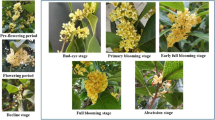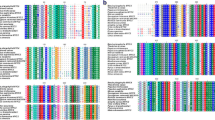Abstract
Tyrosine/dihydroxyphenylalanine decarboxylase (TYDC) and the berberine bridge enzyme (BBE) represent the entry point and a key branch point, respectively, in the biosynthesis of benzylisoquinoline alkaloids in select species of the Papaveraceae and Fumariaceae. Genomic clones for tydc7 and bbe1 from opium poppy (Papaver somniferum L.) were isolated. Deletion analysis of tydc7 and bbe1 5′-flanking regions revealed the location of putative regulatory domains necessary for expression of the β-glucuronidase (gus) reporter gene in a transient assay system based on the microprojectile bombardment of cultured opium poppy cells. A 105-nucleotide region between −393 and −287 of the tydc7 5′-flanking region, and a 155-nucleotide region between −355 and −200 of the bbe1 5′-flanking region, were found to be essential for promoter activity. RNA gel blot analysis showed that tydc7 and bbe1 expression is induced in cultured opium poppy cells in response to wounding or treatment with a pathogen-derived elicitor. Time-courses for the induction of tydc7 and bbe1 mRNAs in wounded cells were nearly identical to those for GUS activity in cells bombarded with select promoter-gus constructs when the −393 to −287 region of tydc7, or the −355 to −200 region of bbe1, was present. Our data suggest that the wound signal caused by the entry of DNA-coated microcarriers into opium poppy cells was sufficient to induce tydc7 and bbe1 promoter activity, and that wound-responsive regulatory elements are located within domains identified by deletion analysis.
Similar content being viewed by others
References
Bauer, W. and Zenk, M.H. 1991. Two methylenedioxy bridge forming cytochrome P-450 dependent enzymes are involved in (S)-stylopine biosynthesis. Phytochemistry 30: 2953-2961.
Blechert, S., Brodschelm, W., Hölder, S., Kammerer, L., Kutchan, T.M., Mueller, M.J., Xia, Z.-Q. and Zenk, M.H. 1995. The octadecanoid pathway: signal molecules for the regulation of secondary pathways. Proc. Natl. Acad. Sci. USA 92: 4099-4105.
Bracher, D. and Kutchan, T.M. 1992. Strictosidine synthase from Rauwolfia serpentina: analysis of a gene involved in indole alkaloid biosynthesis. Arch. Biochem. Biophys. 294: 717-723.
Bradford, M.M. 1976. A rapid and sensitive method for quantitation of microgram quantities of protein using the principle of proteindye binding. Anal. Biochem. 72: 248-254.
Cline, S.D. and Coscia, C.J. 1988. Stimulation of sanguinarine production by combined fungal elicitation and hormonal deprivation in cell suspension cultures of Papaver bracteatum. Plant Physiol. 86: 161-165.
Calzone, F.J., Britten, R.J. and Davidson, E.H. 1987. Mapping of gene transcripts by nuclease protection assays and cDNA primer extension. Meth. Enzymol. 152: 611-632.
de Wet, J.R., Wood, K.V., deLuca, M., Helinski, D.R. and Subramani, S. 1987. Firefly luciferase gene: structure and expression in mammalian cells. Mol. Cell. Biol. 7: 725-737.
Dittrich, H. and Kutchan, T.M. 1991. Molecular cloning, expression, and induction of berberine bridge enzyme, an enzyme essential to the formation of benzophenanthridine alkaloids in the response of plants to pathogenic attack. Proc. Natl. Acad. Sci. USA 88: 9969-9973.
Dixon, R.A. and Paiva, N.L. 1995. Stress-induced phenylpropanoid metabolism. Plant Cell 7: 1085-1097.
Dzink, J.L. and Socransky, S.S. 1985. Comparative in vivo activity of sanguinarine against oral microbial isolates. Antimicrob. Agents Chemother. 27: 663-665.
Eilert, U., Kurz, W.G.W. and Constabel, F. 1985. Stimulation of sanguinarine accumulation in Papaver somniferum cell cultures by fungal elicitors. J. Plant Physiol. 119: 65-76.
Facchini, P.J. and De Luca, V. 1994. Differential and tissue-specific expression of a gene family for tyrosine/dopa decarboxylase in opium poppy. J. Biol. Chem. 269: 26684-26690.
Facchini, P.J. and De Luca, V. 1995. Phloem-specific expression of tyrosine/dopa decarboxylase genes and the biosynthesis of isoquinoline alkaloids in opium poppy. Plant Cell 7: 1811-1821.
Facchini, P.J., Johnson, A.G., Poupart, J. and De Luca, V. 1996a. Uncoupled defense gene expression and antimicrobial alkaloid accumulation in elicited opium poppy cell cultures. Plant Physiol. 111: 687-697.
Facchini, P.J., Penzes, C., Johnson, A.G. and Bull, D. 1996b. Molecular characterization of berberine bridge enzyme genes from opium poppy. Plant Physiol. 112: 1669-1677.
Facchini, P.J., Penzes-Yost, C., Samanani, N. and Kowalchuk, B. 1998. Expression patterns conferred by tyrosine/dihydroxyphenylalanine decarboxylase promoters from opium poppy are conserved in transgenic tobacco. Plant Physiol. 118: 69-81.
Feinberg, A.P. and Vogelstein, B. 1984. A technique for radiolabeling DNA restriction endonuclease fragments for high specific activity. Anal. Biochem. 137: 266-269.
Frenzel, T., Beale, J.M., Kobayashi, M., Zenk, M.H. and Floss, H.G. 1988. Stereochemistry of enzymatic formation of the berberine bridge in protoberberine alkaloids. J. Am. Chem. Soc. 110: 7878-7880.
Frenzel, T. and Zenk, M.H. 1990. S-Adenosyl-L-methionine: 30-hydroxy-N-methyl-(S)-coclaurine-40-O-methyltransferase, a regio-and stereoselective enzyme of the (S)-reticuline pathway. Phytochemistry 29: 3505-3511 (1990).
Gamborg, O.L., Miller, R.O. and Ojima, K. 1968. Nutrient requirements of suspension cultures of soybean root cells. Exp. Cell Res. 50: 151-158.
Hauschild K., Pauli H.H., Kutchan, T.M. 1998. Isolation and analysis of a gene bbe1 encoding the berberine bridge enzyme from the California poppy Eschscholzia californica. Plant Mol. Biol. 36: 473-478.
Holton, T.A. and Cornish, E.C. 1995. Genetics and biochemistry of anthocyanin biosynthesis. Plant Cell 7: 1071-1083.
Jefferson, R.A., Kavanagh, T.A. and Bevan, M.W. 1987. GUS fusions: _-glucuronidase as a sensitive and versatile gene fusion marker in higher plants. EMBO J. 6: 3901-3907.
Kutchan, T.M. 1988. Molecular genetics of plant alkaloid biosynthesis. In: G. Cordell <nt>(Ed.)</nt>, The Alkaloids, vol. 50, Academic Press, San Diego, pp. 257-316.
Kutchan, T.M. 1995. Alkaloid biosynthesis: the basis for metabolic engineering of medicinal plants. Plant Cell 7: 1059-1070.
Logemann, J., Schell, J. and Willmitzer, L. 1987. Improved method for the isolation of RNA from plant tissues. Anal. Biochem. 163: 16-20.
Marques, I.A. and Brodelius, P.E. 1988. Elicitor-induced L-tyrosine decarboxylase from plant cell suspension cultures. I. Induction and purification. Plant Physiol. 88: 47-51.
McKendree, W.L., Paul, A.-L., DeLisle, A.J. and Ferl, R.J. 1990. In vivo and in vitro characterization of protein interactions with the dyad G-box of the Arabidopsis Adh gene. Plant Cell 2: 207-214.
Murray, M. and Thompson, W.F. 1990. Rapid isolation of high molecular weight plant DNA. Nucl. Acids Res. 8: 4321-4325.
Nessler, C.L. and Mahlberg, P.G. 1977. Cell wall perforations in laticifers of Papaver somniferum L. Bot. Gaz. 138: 402-408.
Nessler, C.L. and Mahlberg, P.G. 1978. Ontogeny and cytochemistry of alkaloid vesicles in laticifers of Papaver somniferum L. Am. J. Bot. 64: 541-551.
Rueffer, M. and Zenk, M.H. 1987. Distant precursors of benzylisoquinoline alkaloids and their enzymatic formation. Z. Naturforsch. 42C: 319-332.
Sambrook, J., Fritsch, E.F. and Maniatis, T. 1989. Molecular Cloning: A Laboratory Manual, 2nd ed., Cold Spring Harbor Laboratory, Cold Spring Harbor, NY.
Sanger, F., Nicklen, S. and Coulson, A.R. 1977. DNA sequencing with chain-terminating inhibitors. Proc. Natl. Acad. Sci. USA 74: 5463-5467.
Schulze-Lefert, P., Becker-André, M., Schulz, W., Hahlbrock, K. and Dangl, J.L. 1989. Functional architecture of the lightresponsive chalcone synthase promoter from parsley. Plant Cell 1: 707-714.
Schumacher, H.-M., Gundlach, H., Fiedler, F. and Zenk, M.H. 1987. Elicitation of benzophenanthridine alkaloid biosynthesis in Eschscholtzia cell cultures. Plant Cell Rep. 6: 410-413.
Stadler, R., Kutchan, T.M., Löffler, S., Nagakura, N., Cassels, B.K. and Zenk, M.H. 1987. Revisions of the early steps of reticuline biosynthesis. Tetrahedron Lett. 28: 1251-1254.
Stadler, R., Kutchan, T.M. and Zenk, M.H. 1989. Norcoclaurine is the central intermediate in benzylisoquinoline alkaloid biosynthesis. Phytochemistry 28: 1083-1086.
Staiger, D., Kaulen, H. and Schell, J. 1989. A CACGTG motif of the Antirrhinum majus chalcone synthase promoter is recognized by an evolutionarily conserved nuclear protein. Proc. Natl. Acad. Sci. USA 86: 6930-6934.
Steffens, P., Nagakura, N. and Zenk, M.H. 1985. Purification and characterization of the berberine bridge enzyme from Berberis beaniana cell cultures. Phytochemistry 24: 2577-2583.
Tanahashi, T. and Zenk, M.H. 1990. Elicitor induction and characterization of microsomal protopine-6-hydroxylase, the central enzyme in benzophenanthridine alkaloid biosynthesis. Phytochemistry 29: 1113-1122.
Author information
Authors and Affiliations
Rights and permissions
About this article
Cite this article
Park, SU., Johnson, A.G., Penzes-Yost, C. et al. Analysis of promoters from tyrosine/dihydroxyphenylalanine decarboxylase and berberine bridge enzyme genes involved in benzylisoquinoline alkaloid biosynthesis in opium poppy. Plant Mol Biol 40, 121–131 (1999). https://doi.org/10.1023/A:1026433112119
Issue Date:
DOI: https://doi.org/10.1023/A:1026433112119




